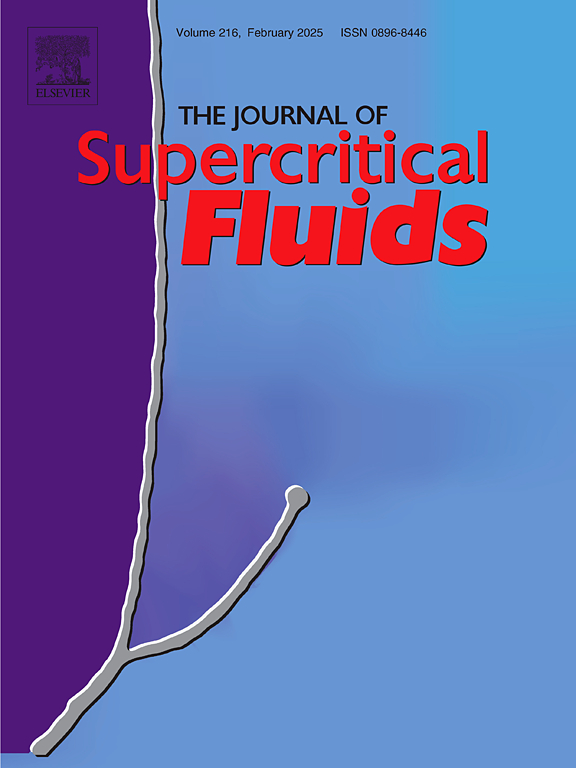Supercritical water co-oxidation of swine manure with methane and lignite in the flow mode
IF 3.4
3区 工程技术
Q2 CHEMISTRY, PHYSICAL
引用次数: 0
Abstract
This paper presents the results of a comparative study of supercritical water (SCW) co-oxidation of swine manure (SM) with methane and lignite continuously fed into a flow reactor. The tests were carried out at a temperature gradient along the vertical axis of the reactor (390–600 °C), a pressure of 25 MPa, varying reactant flow rates and oxidation ratio (OR). An analysis of the time dependence of the reactor wall temperature and the power of the resistive heaters was carried out and has shown that, compared to the SCW oxidation of SM, its co-oxidation with methane and lignite led to a 1.5 and 1.8-fold reduction in the power of the heaters, respectively. The gas products were found to be CO2, N2, and traces of N2O. Saturated carboxylic acids C5–C16, N-bearing aromatics, phenols, chlorophenols, and polycyclic aromatic hydrocarbons (PAHs) were identified in the aqueous effluent by gas chromatography-mass spectrometry. The levels of phenols, chlorophenols, and PAHs in the effluent decreased with increasing OR and with the addition of NaOH. At OR ≥ 1.14, their contents were below the maximum permissible concentrations of these compounds in wastewater. Furthermore, the co-oxidation of SM and lignite increases the content of carboxylic acids, nitrate and sulfate ions in the effluent. The formation of mineral acids during the SCW oxidation of SM intensifies the corrosion of structural materials, resulting in increased contents of chromium, copper, and nickel in the effluent. The paper discusses the transformation mechanisms of organic and mineral components of SM and lignite, as well as ecological aspects of contaminants migration and the efficiency of their removal by SCW oxidation in the SCW/O2 fluid.
猪粪与甲烷和褐煤在流动模式下的超临界水共氧化
本文介绍了在流动反应器中连续进料甲烷和褐煤对猪粪进行超临界水共氧化的对比研究结果。试验在沿反应器垂直轴的温度梯度(390-600 °C)下进行,压力为25 MPa,不同的反应物流量和氧化比(OR)。对反应器壁温和电阻加热器功率的时间依赖性进行了分析,结果表明,与SM的SCW氧化相比,其与甲烷和褐煤的共氧化分别导致加热器功率降低1.5和1.8倍。气体产物被发现是CO2, N2和微量的N2O。采用气相色谱-质谱联用技术对出水中的饱和羧酸C5-C16、含n芳烃、酚类、氯酚类和多环芳烃(PAHs)进行鉴定。出水中酚类、氯酚类和多环芳烃的含量随着OR的增加和NaOH的加入而降低。OR≥ 1.14时,其含量低于废水中这些化合物的最大允许浓度。此外,SM和褐煤的共氧化提高了出水中羧酸、硝酸盐和硫酸盐离子的含量。SCW氧化SM过程中形成的无机酸加剧了对结构材料的腐蚀,导致出水中铬、铜和镍的含量增加。本文讨论了SM和褐煤的有机和矿物成分的转化机制,以及污染物迁移的生态方面以及SCW/O2流体中SCW氧化去除它们的效率。
本文章由计算机程序翻译,如有差异,请以英文原文为准。
求助全文
约1分钟内获得全文
求助全文
来源期刊

Journal of Supercritical Fluids
工程技术-工程:化工
CiteScore
7.60
自引率
10.30%
发文量
236
审稿时长
56 days
期刊介绍:
The Journal of Supercritical Fluids is an international journal devoted to the fundamental and applied aspects of supercritical fluids and processes. Its aim is to provide a focused platform for academic and industrial researchers to report their findings and to have ready access to the advances in this rapidly growing field. Its coverage is multidisciplinary and includes both basic and applied topics.
Thermodynamics and phase equilibria, reaction kinetics and rate processes, thermal and transport properties, and all topics related to processing such as separations (extraction, fractionation, purification, chromatography) nucleation and impregnation are within the scope. Accounts of specific engineering applications such as those encountered in food, fuel, natural products, minerals, pharmaceuticals and polymer industries are included. Topics related to high pressure equipment design, analytical techniques, sensors, and process control methodologies are also within the scope of the journal.
 求助内容:
求助内容: 应助结果提醒方式:
应助结果提醒方式:


